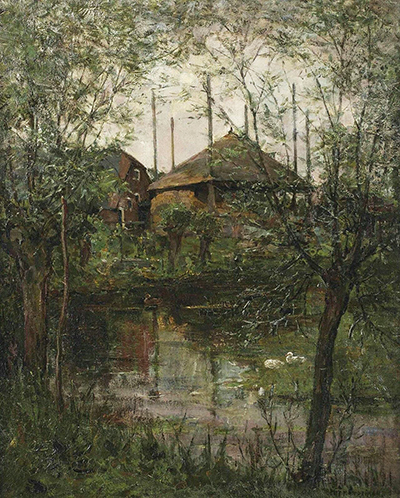Haystack with Willow Trees is a painting by Piet Mondrian which is loosely dated at around 1897 and 1898, meaning the artist would have been in his mid to late twenties at the time.
The painting is 58cm wide, by 70cm tall. Typically, landscape paintings would not be in this aspect ratio but Mondrian wanted a vertically-dominant layout in order to allow him to focus on the river as it travels upwards towards the top of the canvas. Information on the painting is relatively scarce but it is believed to now be owned by a Swiss individual, named Mrs. A.M. Gilles-Koop, having been purchased from a collector in the late 20th century. It has taken some time to collate a full listing of the artist's work because of how many items have been disersed across different collections, but in 1998 efforts were made to put together a truly exhaustive catalogue raisonne of his achievements. Haystack with Willow Trees may have since been sold on again, and was known to have been featured in a Sotheby's sale some years ago, though without a winning bid coming on that particular date. The item's inclusion within a listing of the artist's work now means it should be tracked more precisely from now on.
In terms of the composition itself, we find a calm river curving past us, arriving from the right hand side and then leading upwards towards some buildings in the distance. In the nearest foreground we discover the bank on which the artist would have been sat in order to complete the piece. Several buildings can be seen at the back of the work, with interesting rounded roofs with pointed tops that must have been a traditional style of architecture found in this Dutch region at the time. Several tall beams reach up into the sky, perhaps suggesting that building work is ongoing. There is also some sort of construction which appears to cross the river, but it is hard to make out if this is an established bridge because of how the artist merges colours and forms together, making some detail hard to decipher accurately. There are also some small ducks or swans to the right hand side which brings a rare bright touch of colour to the piece.
Mondrian was highly focused on landscape art within his twenties and was far removed from the styles that he became much more famous for in later life. There is a strong following for these earlier artworks, particularly within his native Netherlands where most of these artworks were based. He produced charming scenes of everyday life, though typically placed nature ahead of humanity in the balance of his paintings. One would therefore see signs of human life, but not allow it to dominate as you might have seen in the work of artists like Bruegel. Instead, we find charming scenes to relax and appreciate the natural beauty of the artist's home nation. One can find many more examples of this approach from Mondrian between around 1895-1900 and is an underrated period in his career, though this is starting to change for the first time in recent years.




